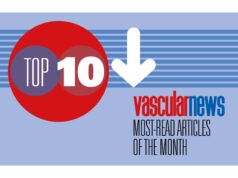
New ACT 1 subgroup analysis demonstrates that in female patients the rate of ipsilateral stroke is lower with carotid artery stenting (CAS) compared with endarterectomy (CEA), while in highly atherosclerotic patients stenting seems to deliver better overall long-term results than endarterectomy.
The data, presented by Gary Ansel (Columbus, USA) the Vascular Interventional Advances 2017 conference (VIVA; 11–14 September, Las Vegas, USA), with Ansel noting that the results for female patients are significant as they are discordant with those reported in the CREST trial, while the findings for highly atherosclerotic patients are concordant with data from the CAPTURE 2 trial. Furthermore, the ACT 1 patient cohort represents the largest dataset of randomised asymptomatic carotid stenosis patients treated by experienced operators since the CREST trial.
ACT 1 was a prospective, multicentre, randomised trial to support the approval of the Xact rapid exchange carotid stent system and the Emboshield embolic protection systems (both Abbott Vascular) in asymptomatic extra-cranial carotid atherosclerosis patients—the largest randomised trial of its kind to investigate asymptomatic patients. The trial randomised 1,453 patients 3:1 to CAS:CEA and followed them to five years, finding that the treatments were non-inferior at one year (p=0.01) and that at five years there was no difference in any stroke or survival between the groups.
The current analysis evaluated the performance of CAS and CEA in the gender and varying atherosclerotic disease burden subgroups.
The gender subgroup included 212 women and 278 men with no difference in baseline risk factors between the two groups. There was no difference in ipsilateral stroke-free survival rates between the male CAS (96.9%) and CEA (97.9%) patients between 31 days and five years post-procedure (p=0.54). For female patients, the CAS group had a five-year ipsilateral stroke-free survival rate of 99.2% compared with 96.5% in the CEA group (p=0.02).
The patients in the atherosclerotic subgroup were divided into four groups: carotid only (n=161), carotid plus coronary artery disease (CAD; n=141), carotid plus peripheral artery disease (PAD; n=65), and carotid plus CAD plus PAD (n=109). There was no difference in other risk factors between the groups at baseline.
Ansel reported that there was no difference in the rate of a composite of 30-day death, stroke, and myocardial infarction or ipsilateral stroke from 31 days to five years between the carotid only, carotid plus CAD and carotid plus PAD groups. However, in the carotid plus CAS plus PAD group—those with the highest atherosclerotic burden—the five year event-free survival rate was 93.9% for CAS compared with 85.6% for CEA (p=0.04).
This trend was also observed when looking only at ipsilateral stroke at five years, with no difference between the first three groups, but carotid plus CAD plus PAD patients exhibiting a five-year freedom from ipsilateral stroke of 97.8% with CAS and 91.8% with CEA (p=0.04).
“We look forward to the results of CREST 2—even though it will not directly compare the groups analysed here—to learn more about these groups of patients,” Ansel said.












